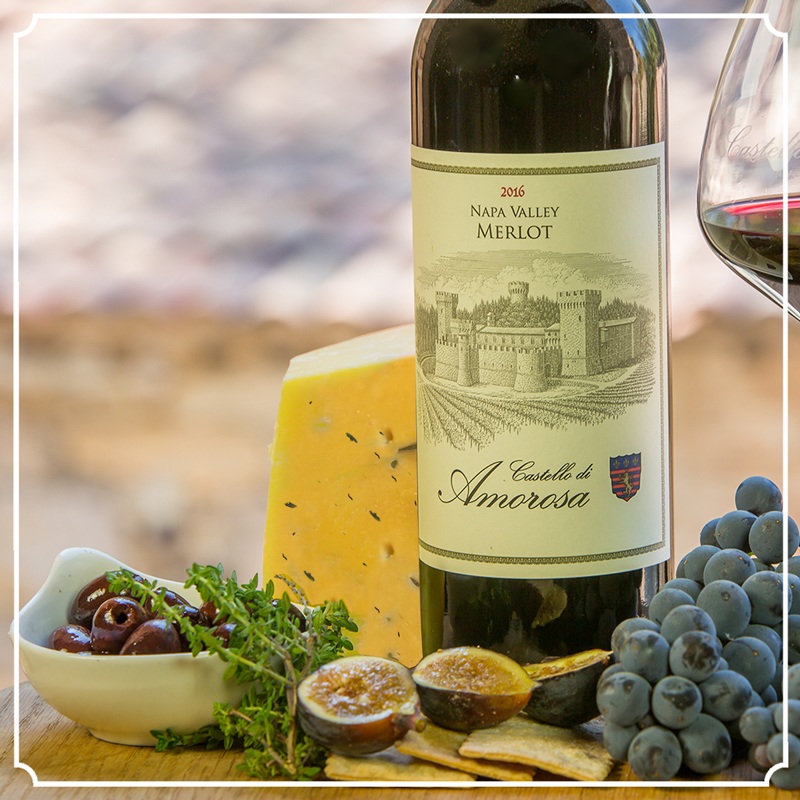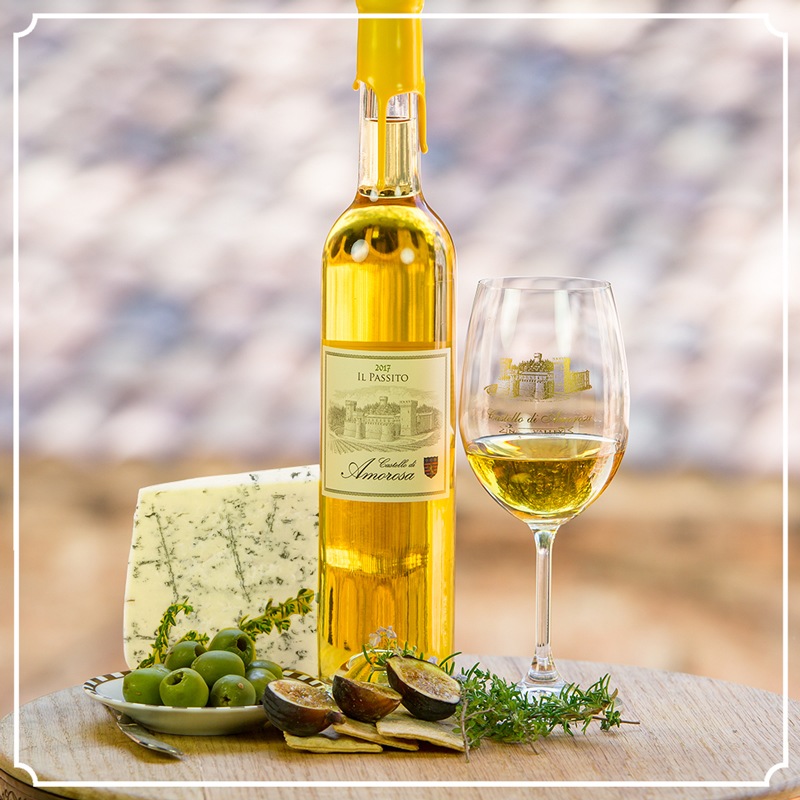

Wine & Cheese Pairings
Raise a glass to one of the best duos in history, Wine & Cheese. Many pairings that are considered classics, emerged from the centuries-old relationship between a region’s cuisine and their wines. This powerful duo remains the key to our heart and maybe some Castle doors. While enjoying our Castello wines, there are a few tried & true combinations that will standout.
There are many factors that go into the pairing of wine and cheese. The best pairings complement each other particularly well when considering texture, fat, acidity, and salt.
In addition to drying and concentrating the cheese, age introduces new flavors. Rind cheeses like Brie remain gooey and spreadable, but the cheese develops earthy notes after a few months of aging in the caves. Older cheeses like Gruyère acquire deep nutty flavors. Blue cheeses develop pungency from the mold in their veins. Washed-rind cheeses like Époisses develop a funky, flavor that you either love or hate.
Wines also run the spectrum from delicate to bold, and their depth and complexity can correlate with their age. Young wines are fresh and spirited, with lively aromas and bright flavors of fruits, flowers, citrus, herbs, or spice. Wines that have spent time in cask or bottle have had a chance to acquire more nuance. In addition to their primary fruit, they take on secondary notes of oak, toast, earth, oxidation, minerals, and more. Like cheeses, these wines tend to be more complex and savory than their younger counterparts.

A Divine Pairing From The Gods
In a study at ChemoSens in France, researchers determined that cheese improved the perception of fruit aromas, reduced the duration of astringency of red wines, and heightened the taste of white wine. Cheese which is customarily high in fat, coats the mouth and blocks taste receptors to beverages. The acidity and sweetness of a well-paired wine can cut through this creamy barrier to create an excellent mouthfeel.
Cheeses vary in moisture content, fat content, texture and flavor. Wines also vary in acidity, sweetness, body, and structure. A few basic guidelines will bring you cheese & wine success.
The main concept behind pairings is that certain elements (such as texture and flavor) in both cheese and wine interact with each other, and thus finding the right combination of these elements will make the entire dining experience more enjoyable.

Rules of Cheese & Wine Pairing
Pair by flavor intensity. Consider the effect age has on the intensity of wine. We can see how young cheeses might partner best with sparkling crisp whites, dry rosés, and reds with good acidity. Older cheeses need wines with more body and complexity. The oldest cheeses, those that are the most rich and nutty, pair best with wines that have ample body and structure. Cheeses become bolder and more complex as they age, taking on concentrated flavors. If you have a 3 year aged cheddar, it’s going to have a richness to it that needs a wine with an equal amount of depth.
Pay Attention To Texture. Cheese changes drastically in texture, which is based on what type of milk, what style of cheese, and how long it has been aged for. Young, fresh, and rindless cheeses are soft, and when served at room-temperature can become gooey. Hard cheeses, on the other hand, need to be crumbled or cut.
Watch those tannins. Tannic rich red wines pair wonderfully with bold aged cheeses, tannins help bind to protein and fat. T same process makes tannic wines feel far too astringent with young cheeses; they tie up what little fat’s available, leaving you with a chalky and metallic aftertaste.
Salt loves sweet. Sweet wines balance the salty cheeses like Blue cheese, aged Gouda or Feta. The salt in the cheese increases the sweetness in the wine.
Cheese loves fruit and nuts. Fruits go very well with young cheeses like Brie. Sweet dried fruits are wonderful with salty cheeses like Blue, Buttery, bitter nuts are tasty with rich Cheddar.

Castello Wine & Cheese Pairings Guide
Explore our favorite Castello wine & cheese pairings. Try these basic wine and cheese combinations at home.
- Cheddar – Cabernet Sauvignon
- Cotswald – Merlot
- Pecorino Toscano – Sangiovese
- Grueyere – Pinot Noir
- Brie – Spumante del Castello
- La Tur – Gewürztraminer
- Goat Cheese – Pinot Grigio
- Goat Cheese – Pinot Bianco
- Fiore Sardo – Vermentino
- Pepper Jack – Gioia
- Blue Cheese – Il Passito
- Gorgonzola – Moscato
Kick it up a notch. Add these elements to elevate a cheese pairing to a sweet and salty palate sensation. These items also make a great addition to any charcuterie board.
- Nuts – Buttery, bitter nuts are tasty with rich cheeses like Cheddar.
- Fruits – Fruits go very well with young cheeses like Brie. Sweet dried fruits are wonderful with salty cheeses like Blue cheese.
- Balsamic Reduction – Serve over hard cheeses or a Caprese Salad. A reduction of balsamic will elevate a cheese pairing to a sweet and salty palate sensation.
- Honey – This is an elegant addition to any wine & cheese board. Honey adds a fair bit of complexity to a long list of cheeses. The key to pairing honey and cheese is to pair a light honey with a mild cheese and more rounded flavored honey with a more intense cheese. Among the best honey & cheese pairings are Provolone cheese and Cabernet Sauvignon. Honey & blue cheese create a contrast that could create a fan of even the harshest blue cheese critics. Goat cheeses, Gorgonzola, Pecorino Romano, Brie all go great with honey.

Cabernet Sauvignon & Cheddar
Americas most popular wine has a bevy of cheeses that work well. Complex flavors often stand up the best to sophisticated profile of Cabernet Sauvignon. Your best cheese for this wine is aged Cheddar which will stand up to the strong cheddar with its lingering after taste.
Why it works: These semi-hard/hard style cheeses help to elevate the dark fruit flavors of the wine. However try to remember the bigger the oak in the wine, the fewer the cheese choices you have.
Also try: Aged Gouda, Comté

Merlot & Cotswald
This is where rich fatty cheeses can play, cheddar or my fave, Cotswald which I lovingly call Baked potato cheese as it is creamy, buttery, and full-flavored like cheddar. The cheese has chives and onions so it is rich & savory. Perfect for the tannins in merlot.” – Castle Sommelier Mary Davidek
Why it works: Cotswald is a creamy Double Gloucester cheese laced with onion and chives. The rich creamy Cotswald plays well with the tannic Merlot.
Also try: Asiago, Brick, Muenster, Gouda and Colby

Sangiovese & Pecorino
Both eternally popular in Italy, the pair have been friends for well over 100 years. The beloved Italian grape brings bright cherry, earthy tomato, and savory garden herb to the table while the aged Parmigiano-Reggiano brings a rich complex nuttiness. Sangiovese also pairs well with the very popular Parmesan and Mozzarella.
Why it works: Sangiovese is known for its full body, acidity, and bold character. The complex character of a Pecorino brings a rich nuttiness with the vibrant acidity of Sangiovese.
Also try: Parmigiano, Grana padan, Fontina, Mozzarella

Pinot Noir & Grueyere
Pinot Noir works well with most soft cheeses but the nutty flavors of the Grueyere play a great contrast to the dark fruits in Pinot Noir. The subtle acidity and polished tannins further the complex relationship in the pairing.
Why it works: The berry fruit in the rich red wine complements the flavor of this medium-firm cheese without overpowering it. They both have just enough aroma and complexity to make things interesting.
Also try: Comté, Emmenthal, Goud

Spumante & Brie Cheese
Triple-cream soft cheeses (brie, Camembert) are the perfect match. But there are more great cheese pairings with Champagne and other sparkling wines.
Why it works: The sparkling wines crisp acidity plays well with the complex buttery and earthy flavors of Brie. The sparkling notes help temper the thick creamy texture and leave a refreshed mouthfeel.
Also try: Camembert, Roquefort

Gewürztraminer & La Tur
La Tur is an Italian triple cream from the Piedmont region of Italy and is made from an equal mixture of cow, sheep and goat milk. Typically with double and triple creams a bright white wine like dry Gewurztraminer can work best. Typically salty cheeses and Gewürztraminer are not the best together, so opt instead for mild cow’s milk cheeses.
Honey can be added to this duo for an extra flavor sensation.
Why it works: The heavy triple cream can be easily cut through by the bright dry Gewürztraminer, making for a refreshed palate and mouthfeel.
Also try: Muenster, Gruyère, Roquefort, Capocollo, Stilton, Gorgonzola, Gouda, Boursin, Swiss cheese, Pepper Jack

Pinot Bianco & Goat Cheese
“The tang sweetness combined with a creamy goat cheese like Sonoma chevre by Laura Chenel or Capricho de Cabra from Spain, drizzle a little of our Basil grape seed oil on it and total Goat love with Pinot Bianco.” – Castle Sommelier Mary Davidek
Why it works: The crisp acidity of Pinot Bianco is the perfect compliment to the creamy fatty notes of Goat Cheese.
Also try: Feta, Baby Swiss, Gouda, Majorero, Mahon, Dry Jack

Pinot Grigio & Goat Cheese
Because of its tangy and salty flavor, it pairs well with the crisp fruitiness of Pinot Grigio.
Why it works: The crisp acidity of Pinot Grigio is the perfect compliment to the creamy fatty notes of Goat Cheese.
Also try: Fresh Mozzarella, Mild Cheddars, Brie, Baby Swiss

Vermentino & Fiore Sardo
Believed to date back to the Bronze Age, Fiore Sardo hails from the second largest island in the Mediterranean Sea, Sardinia, Italy. A lighter, crisper white wine like Vermentino, tends to be refreshing and fruity which works well with the semi-hard, smoked cheese.
When drinking Vermentino you should always avoid overly pungent fromage and focus on fresh cheeses.
Why it works: This is one of those hyper-regional parings. Both Vermentino and pecorino come from the small island of Sardegna, Italy. Engulfed by the salty sea, both the grape vines and the scrubby bush the sheep feed on take on similar light, savory, citrus, and salty characteristics.
Also try: Ricotta, Buffalo Mozzarella, Goat Cheese, Pecorino, Feta

Gioia & Pepper Jack
Dry fruit rosé can handle a little spice and heat. This sangiovese based rosé is no different boasting bright berry and melon flavors. Rosé boasts a versatility that allows it to work well with several different cheeses.
Why it works: The bright fruit can help graze through the spicy notes of Pepper Jack.
Also try: Comté, Monterey Jack

Il Passito (Sauterne Style) & Blue Cheese
Big salty cheese pair wonderfully with the sweet flavors from the sauterne. The sweetness of Il Passito is an excellent foil for the sharp savory flavors of a number of famous and strongly-flavored cheeses.
Why it works: Balance plays a big role in making these combinations so special.
Also try: Blue Cheese (Stilton or Roquefort), Port Salut, Red Square, Triple Cream Brie, Epoisse

Moscato & Gorgonzola
Moscato is a sweet, fruity wine with hints of candied peach, orange blossom, and honeydew melon. Gorgonzola is a blue cheese that ranges from creamy and soft to firm and crumbly. It’s full-flavored with earthy undertones of saltiness. The age of Gorgonzola determines the overall creaminesss. This wine & cheese pairing is also tremendous with the addition of honey.
Why it works: The sweet notes of the Moscato is balanced perfectly with the salty flavors from Gorgonzola.
Also try: Munster


